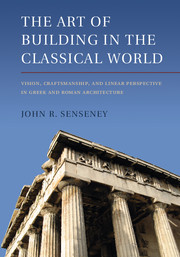 The Art of Building in the Classical World
The Art of Building in the Classical World Book contents
- Frontmatter
- Contents
- List of Figures
- Preface
- Note on Dates and Translations
- Abbreviations
- INTRODUCTION: CHALLENGES OF ANALYSIS AND INTERPRETATION
- 1 THE IDEAS OF ARCHITECTURE
- 2 VISION AND SPATIAL REPRESENTATION
- 3 THE GENESIS OF SCALE DRAWING AND LINEAR PERSPECTIVE
- 4 ARCHITECTURAL VISION
- Excursus: Envisioning Cosmic Mechanism in Plato and Vitruvius
- Appendix A Analysis of the Dimensions of the Blueprint for Entasis at Didyma
- Appendix B Analysis of the Hypothetical Working Drawing for Platform Curvature at Segesta
- Appendix C Analysis of the Hypothetical Working Drawing for Platform Curvature in the Parthenon
- Notes
- References
- Index
2 - VISION AND SPATIAL REPRESENTATION
Published online by Cambridge University Press: 07 October 2011
- Frontmatter
- Contents
- List of Figures
- Preface
- Note on Dates and Translations
- Abbreviations
- INTRODUCTION: CHALLENGES OF ANALYSIS AND INTERPRETATION
- 1 THE IDEAS OF ARCHITECTURE
- 2 VISION AND SPATIAL REPRESENTATION
- 3 THE GENESIS OF SCALE DRAWING AND LINEAR PERSPECTIVE
- 4 ARCHITECTURAL VISION
- Excursus: Envisioning Cosmic Mechanism in Plato and Vitruvius
- Appendix A Analysis of the Dimensions of the Blueprint for Entasis at Didyma
- Appendix B Analysis of the Hypothetical Working Drawing for Platform Curvature at Segesta
- Appendix C Analysis of the Hypothetical Working Drawing for Platform Curvature in the Parthenon
- Notes
- References
- Index
Summary
Even with Plato's subsequent elaboration on the relationship between craftsmanship and cosmic mechanism in the Timaeus, the Republic's comparison of the diagrams of Daidalos (or another craftsman or painter) and the motions of heavenly bodies may seem strange, perhaps exceedingly so. In looking into the formal and conceptual connections shared by Greek diagrams of cosmic mechanism and the graphic underpinnings of round and partially round Greek buildings, this chapter attempts to demonstrate the naturalness of Plato's comparison in the larger context of classical visual culture. Specifically, I aim to show how in the Classical period, the design of the Greek theater as a circular and radial construction relates to theories of vision, the recent invention of linear perspective, and astronomical drawings representing the revolutions of bodies in space and the passage of time. The revealed connections help locate an early application of ichnography in the design of the theater as a vessel for communal vision. They also demonstrate a nexus of conceptual associations available to Plato when he referred to the diagrams of Daidalos. Finally, they demonstrate that the relationship (or, just as significantly, a simple lack of separation) between building, mechanism, and astronomical timepieces that together define architecture for Vitruvius may be found in notably earlier Greek traditions. This background will serve to more fully inquire into the origins of linear perspective and ichnography in Chapter 3.
- Type
- Chapter
- Information
- The Art of Building in the Classical WorldVision, Craftsmanship, and Linear Perspective in Greek and Roman Architecture, pp. 60 - 103Publisher: Cambridge University PressPrint publication year: 2011


